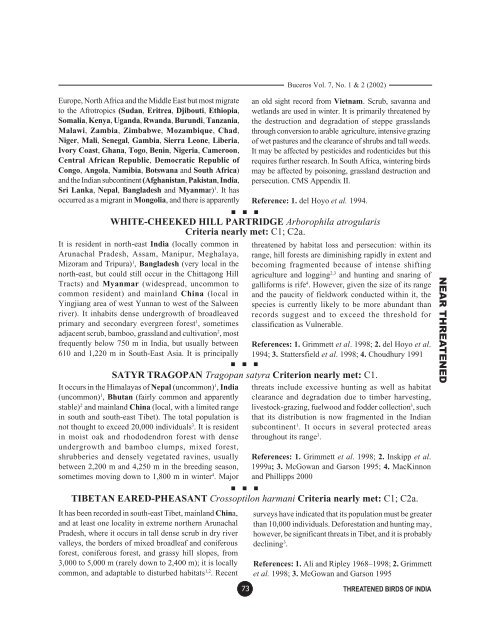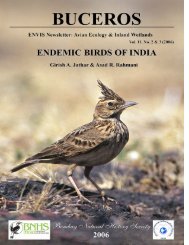Untitled - ENVIS Centre on Avian Ecology
Untitled - ENVIS Centre on Avian Ecology
Untitled - ENVIS Centre on Avian Ecology
Create successful ePaper yourself
Turn your PDF publications into a flip-book with our unique Google optimized e-Paper software.
Europe, North Africa and the Middle East but most migrate<br />
to the Afrotropics (Sudan, Eritrea, Djibouti, Ethiopia,<br />
Somalia, Kenya, Uganda, Rwanda, Burundi, Tanzania,<br />
Malawi, Zambia, Zimbabwe, Mozambique, Chad,<br />
Niger, Mali, Senegal, Gambia, Sierra Le<strong>on</strong>e, Liberia,<br />
Ivory Coast, Ghana, Togo, Benin, Nigeria, Camero<strong>on</strong>,<br />
Central African Republic, Democratic Republic of<br />
C<strong>on</strong>go, Angola, Namibia, Botswana and South Africa)<br />
and the Indian subc<strong>on</strong>tinent (Afghanistan, Pakistan, India,<br />
Sri Lanka, Nepal, Bangladesh and Myanmar) 1 . It has<br />
occurred as a migrant in M<strong>on</strong>golia, and there is apparently<br />
Buceros Vol. 7, No. 1 & 2 (2002)<br />
an old sight record from Vietnam. Scrub, savanna and<br />
wetlands are used in winter. It is primarily threatened by<br />
the destructi<strong>on</strong> and degradati<strong>on</strong> of steppe grasslands<br />
through c<strong>on</strong>versi<strong>on</strong> to arable agriculture, intensive grazing<br />
of wet pastures and the clearance of shrubs and tall weeds.<br />
It may be affected by pesticides and rodenticides but this<br />
requires further research. In South Africa, wintering birds<br />
may be affected by pois<strong>on</strong>ing, grassland destructi<strong>on</strong> and<br />
persecuti<strong>on</strong>. CMS Appendix II.<br />
Reference: 1. del Hoyo et al. 1994.<br />
n n n<br />
WHITE-CHEEKED HILL PARTRIDGE Arborophila atrogularis<br />
Criteria nearly met: C1; C2a.<br />
It is resident in north-east India (locally comm<strong>on</strong> in<br />
Arunachal Pradesh, Assam, Manipur, Meghalaya,<br />
Mizoram and Tripura) 1 , Bangladesh (very local in the<br />
north-east, but could still occur in the Chittag<strong>on</strong>g Hill<br />
Tracts) and Myanmar (widespread, uncomm<strong>on</strong> to<br />
comm<strong>on</strong> resident) and mainland China (local in<br />
Yingjiang area of west Yunnan to west of the Salween<br />
river). It inhabits dense undergrowth of broadleaved<br />
primary and sec<strong>on</strong>dary evergreen forest 1 , sometimes<br />
adjacent scrub, bamboo, grassland and cultivati<strong>on</strong> 2 , most<br />
frequently below 750 m in India, but usually between<br />
610 and 1,220 m in South-East Asia. It is principally<br />
threatened by habitat loss and persecuti<strong>on</strong>: within its<br />
range, hill forests are diminishing rapidly in extent and<br />
becoming fragmented because of intense shifting<br />
agriculture and logging 2,3 and hunting and snaring of<br />
galliforms is rife 4 . However, given the size of its range<br />
and the paucity of fieldwork c<strong>on</strong>ducted within it, the<br />
species is currently likely to be more abundant than<br />
records suggest and to exceed the threshold for<br />
classificati<strong>on</strong> as Vulnerable.<br />
n n<br />
References: 1. Grimmett et al. 1998; 2. del Hoyo et al.<br />
1994; 3. Stattersfield et al. 1998; 4. Choudhury 1991<br />
n<br />
SATYR TRAGOPAN Tragopan satyra Criteri<strong>on</strong> nearly met: C1.<br />
It occurs in the Himalayas of Nepal (uncomm<strong>on</strong>) 1 , India<br />
(uncomm<strong>on</strong>) 1 , Bhutan (fairly comm<strong>on</strong> and apparently<br />
stable) 2 and mainland China (local, with a limited range<br />
in south and south-east Tibet). The total populati<strong>on</strong> is<br />
not thought to exceed 20,000 individuals3 . It is resident<br />
in moist oak and rhododendr<strong>on</strong> forest with dense<br />
undergrowth and bamboo clumps, mixed forest,<br />
shrubberies and densely vegetated ravines, usually<br />
between 2,200 m and 4,250 m in the breeding seas<strong>on</strong>,<br />
sometimes moving down to 1,800 m in winter4 threats include excessive hunting as well as habitat<br />
clearance and degradati<strong>on</strong> due to timber harvesting,<br />
livestock-grazing, fuelwood and fodder collecti<strong>on</strong><br />
. Major<br />
3 , such<br />
that its distributi<strong>on</strong> is now fragmented in the Indian<br />
subc<strong>on</strong>tinent1 . It occurs in several protected areas<br />
throughout its range3 .<br />
References: 1. Grimmett et al. 1998; 2. Inskipp et al.<br />
1999a; 3. McGowan and Gars<strong>on</strong> 1995; 4. MacKinn<strong>on</strong><br />
and Phillipps 2000<br />
n n n<br />
TIBETAN EARED-PHEASANT Crossoptil<strong>on</strong> harmani Criteria nearly met: C1; C2a.<br />
It has been recorded in south-east Tibet, mainland China,<br />
and at least <strong>on</strong>e locality in extreme northern Arunachal<br />
Pradesh, where it occurs in tall dense scrub in dry river<br />
valleys, the borders of mixed broadleaf and c<strong>on</strong>iferous<br />
forest, c<strong>on</strong>iferous forest, and grassy hill slopes, from<br />
3,000 to 5,000 m (rarely down to 2,400 m); it is locally<br />
comm<strong>on</strong>, and adaptable to disturbed habitats 1,2 . Recent<br />
surveys have indicated that its populati<strong>on</strong> must be greater<br />
than 10,000 individuals. Deforestati<strong>on</strong> and hunting may,<br />
however, be significant threats in Tibet, and it is probably<br />
declining 3 .<br />
References: 1. Ali and Ripley 1968–1998; 2. Grimmett<br />
et al. 1998; 3. McGowan and Gars<strong>on</strong> 1995<br />
73 THREATENED BIRDS OF INDIA<br />
NEAR THREATENED




